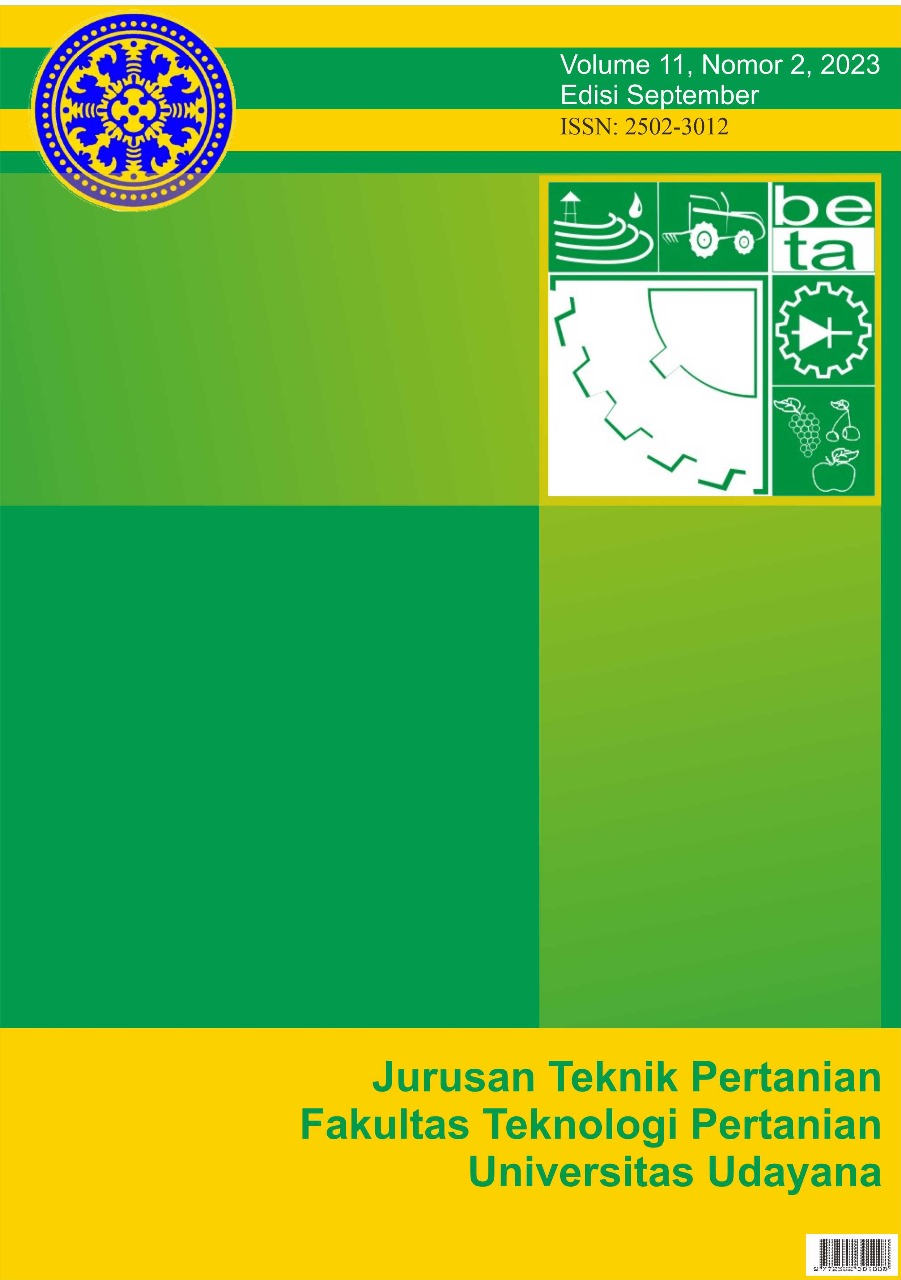Laju Pengomposan Sampah Organik Rumah Tangga pada Berbagai Konsentrasi Mol Air Cucian Beras
Abstract
Abstrak
Pengomposan adalah salah satu solusi dalam mengolah sampah organik rumah tangga. Tujuan penelitian ini adalah untuk mengetahui laju pengomposan sampah organik rumah tangga pada berbagai konsentrasi MOL air cucian beras dan untuk mendapatkan konsentrasi MOL air cucian beras yang menghasilkan kompos sampah organik rumah tangga terbaik sesuai dengan persyaratan teknis minimal kompos padat berdasarkan Keputusan Menteri Pertanian Republik Indonesia No.261/KPTS/SR.310/M/4/2019. Perlakuan dengan menggunakan 30 kg sampah organik rumah tangga untuk satu perlakuan dan masing-masing mengandung konsentrasi MOL air cucian beras 0 ml (kontrol), 30 ml, 60 ml, 90 ml, 120 ml, dan 150 ml. Ke-enam perlakuan tersebut dilakukan 2 kali pengulangan sehingga didapatkan 12 unit percobaan. Parameter pengamatan meliputi kadar awal bahan, Total Plate Count (TPC), suhu, pH, kadar air, electrical conductivity (EC), karbon, nitrogen, C/N rasio, bahan organik (OM). Data yang diperoleh dianalisis dengan Metode Analisis Statistik Deskriptif. Hasil penelitian pengomposan selama 1 bulan menunjukkan seluruh perlakuan memiliki laju pengomposan yang berbeda-beda. Kompos yang dihasilkan memiliki nilai pH 6,8-7,2, kadar air sebesar 25,97%-33,42%, C-organik 30,13%-34,14%, N-total 1,26%-2,21%, C/N rasio 13,63%-26,37%, dan OM 51,95%-58,86%. Perlakuan penambahan 120 ml MOL air cucian beras pada 30 kg sampah organik rumah tangga adalah perlakuan terbaik karena mencapai suhu lingkungan pada hari ke-25, serta mencapai pH netral pada hari ke-21 dan telah memenuhi syarat kompos padat berdasarkan Keputusan Menteri Pertanian Republik Indonesia No.261/KPTS/SR.310/M/4/ 2019.
Abstract
Composting is one of solutions in household organic waste processing. The purpose of the research was to determine the rate of household organic waste composting at different concentrations of rice water MOL and to obtain the concentration of rice water MOL that produce the best household organic waste compost that accordance with minimum technical requirements of solid compost based on Decree of the Minister of Agriculture of Republic Indonesia No.261/KPTS/SR.310/M/4/2019. The treatment used 30 kg of household organic waste for one treatment and each concentrations of rice water MOL was 0 ml (control), 30 ml, 60 ml, 90 ml, 120 ml, 150 ml. The six treatments were repeated 2 times so that obtain 12 experimental units. Observation parameters include initial material content, Total Plate Count (TPC), temperature, pH, water content, electrical conductivity, carbon, nitrogen, C/N ratio, organic matter (OM). The data obtained were analyzed using Descriptive Statistical Analysis Method. Result of the composting study for 1 month showed that all the treatments had different rates of composting. The result of compost has pH value 6,8-7,2, water content 25,97%-33,42%, C-organik 30,13%-34,14%, N-total 1,26%-2,21%, C/N ratio 13,63%-26,37%, and OM 51,95%-58,86%. The treatment of adding 120 ml rice water MOL to 30 kg of household organic waste is the best treatment because it can reached ambient temperature on the 25th day and reached neutral pH on the 21st day and has met requirements of solid compost based on the Decree of the Minister of Agriculture of the Republic Indonesia No.261/KPTS/SR.310/M/4/2019.
Downloads
References
Dahlianah, I. (2015). Pemanfaatan sampah organik sebagai bahan baku pupuk kompos dan pengaruhnya terhadap tanaman dan tanah. Jurnal Klorofil, X(1), 10–13.
Dewi, Oktiawan, W., & Zaman, B. (2016). Pengaruh Penambahan Lindi dan Mol Bonggol Pisang Terhadap Waktu Pengomposan Sampah Organik. Jurnal Teknik Lingkungan, 191–199.
Fadel, I., Madrini, I. A. G. B., & Sumiyati. (2021). Pengaruh Penambahan EM-4 Terhadap Kualitas Kompos Kotoran Gajah. Jurnal BETA (Biosistem Dan Teknik Pertanian), 9(1), 130–137.
Fatmawati, F., Madayanti, W. F., & Puspasari, M. (2016). Identifikasi Bakteri Potensial Penghasil Enzim Amilase, Selulase, Xilanase dan Lipase Pada Fase Termofilik Kompos Manur Sapi. Jurnal Kesehatan Bakti Tunas Husada, 16.
Jumar, Saputra, R. A., & Wafiuddin, M. S. (2020). Teknologi Pengomposan Limbah Kulit Durian Menggunakan EM4. Jurnal Enviro Scienteae, 16(1), 241–251.
Madrini, I. A. G. B., & Sulastri, N. N. (2019). Dinamika Suhu Pengomposan Sampah Organik Rumah Tangga dengan Keranjang Bio Komposter. Jurnal BETA (Biosistem Dan Teknik Pertanian), 7, 204–207.
Madrini, Shibusawa, S., Kojima, Y., & Hosaka, S. (2016). Effect of natural zeolite (Clinoptilolite) on ammonia emissions of leftover foodrice hulls composting at the initial stage of the thermophilic process. Journal of Agricultural Meteorology, 72(1), 12–19. https://doi.org/10.2480/agrmet.D-15-00012
Pranata, I. K. A., Madrini, I. A. G. B., & Tika, I. W. (2022). Efek Penambahan Kotoran Sapi Terhadap Kualitas Kompos pada Pengomposan Batang Pisang. Jurnal BETA (Biosistem Dan Teknik Pertanian), 10(April).
Seni, I. A. Y., Atmaja, I. W. D., & Sutari, N. W. S. (2013). Analisis Kualitas Larutan MOL (Mikoorganisme Lokal) Berbasis Daun Gamal (Gliricidia Sepium). Journal of Tropical Agroecotechnology, 2(2), 135–144.
Setiyo, Y., Purwadaria, H. K., Yuwono, A. S., & Subroto, M. A. (2007). Pengembangan Model Simulasi Proses Pengomposan Sampah Organik Perkotaan Dalam Bioreaktor. Jurnal Forum Pascasarjana, 30, 1–12.
Subandriyo, Anggoro, D. D., & Hadiyanto. (2012). Optimasi Pengomposan Sampah Organik Rumah Tangga Menggunakan Kombinasi Aktivator Em4 Dan Mol Terhadap Rasio C/N. Jurnal Ilmu Lingkungan, 10(2), 70. https://doi.org/10.14710/jil.10.2.70-75
Sundari, I., Maruf, W. F., & Dewi, E. N. (2014). Pengaruh Penggunaan Bioaktivator Em4 Dan Penambahan Tepung Ikan Terhadap Spesifikasi Pupuk Organik Cair Rumput Laut Gracilaria Sp. Jurnal Pengolahan Dan Bioteknologi Hasil Perikanan, 3(3), 88–94.
Utomo, P. B., & Nurdiana, J. (2018). Evaluasi Pembuatan Kompos Organik dengan Menggunakan Metode Hot Composting. Jurnal Teknologi Lingkungan, 2, 28–32.
Wijaya, P. P. A. K. (2019). Perbedaan Kualitas Kompos Limbah Ampas Kopi dengan Penambahan Bioaktivator EM4 dan MOL Nasi Basi. Skripsi. Jurusan Kesehatan Lingkungan. Politeknik Kesehatan Kemenkes Denpasar.
Wulandari, R. N. K., Madrini, I. A. G. B., & Wijaya, I. M. A. (2019). Efek Penambahan Limbah Makanan Terhadap C/N Ratio Pada Pengomposan Limbah Kertas. Jurnal BETA (Biosistem Dan Teknik Pertanian), 8(1), 103. https://doi.org/10.24843/jbeta.2020.v08.i01.p13












 Jurnal BETA (Biosistem dan Teknik Pertanian)
Jurnal BETA (Biosistem dan Teknik Pertanian)


